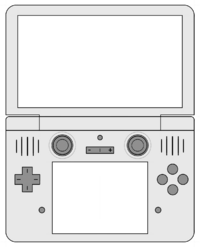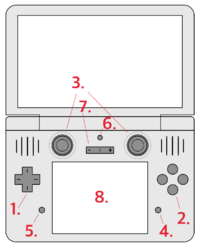Setako Fold3 (Pacifica)
| Developer | Setako Electronic Systems |
|---|---|
| Product family | Setako Fold |
| Type | Handheld console |
| Generation | Ninth |
| Release date | July 23, 2021 |
| Introductory price | ◎55 (~int$180) |
| Units shipped | All models total: 14.7 million (as of December 1 2023) |
| Media |
|
| Operating system | Setako Fold3 system software |
| CPU | Pelektronik Ts18RI quad-core CPU @ 1.07 GHz |
| Memory | 4GB LPDDR5 RAM, 256 MB VRAM |
| Storage | 32GB eUFS |
| Removable storage | 2 x memory card slots; 1 x 32GB memory card included |
| Display |
|
| Graphics | Kihari P9300M @ 410 MHz |
| Sound | 2 x stereo speakers |
| Input | A/B/V/G buttons, 2 x circle sticks, D-pad, L/R bumbers, start/select buttons, volume control slider, power button |
| Camera | 1 x 0.3 MP f/2.85 |
| Connectivity |
|
| Power | 4000 mAh 3.7V Li-ion battery |
| Online services | Setako Online |
| Dimensions | 140mm x 90mm x 30mm |
| Mass | 352 grams |
| Backwards compatibility |
|
| Predecessor | Setako Fold2 |
The Setako Fold3 is a Pelinese ninth-generation handheld gaming console designed and manufactured by Setako Electronic Systems. It was introduced to the Pelinese market in 2021 as a next-generation redesign of the successful Fold2 console, and features greater computational power and storage capacity as well as full backwards compatibility with cartridges from both the Fold2 and the original Fold.
History
Background
Concepts for the form of a Fold2 successor were being explored as early as 2016. Preliminary development studies and conceptualization were both heavily influenced by the enduring presence of smartphone-based mobile gaming, which was rapidly gaining market share in the global video games industry? The handheld gaming consoles that Setako specialized in producing had started to experience strong competition beginning in the late 2000s, during the later years of the original Fold’s life cycle, and increasingly stiff mobile competition against the eighth generation of handhelds led to a relatively disappointing lifecycle performance for the succeeding Fold2. Contemporary executives and market research personnel were divided at the time in their ideas of how Setako could most effectively respond to the challenge of the mobile market, especially on the question of whether the dedicated handheld gaming industry could survive the advent of the smartphone in the long term. Company director Bina Yumebara considered a concerted revitalization of the dedicated handheld to be a better option than attempting to enter a market that, though already immense and rapidly growing, was already reaching critical levels of market oversaturation that would hamper any attempts by Setako to reestablish itself as a mobile hardware and software developer; she later went on to state in a 2016 interview with gaming magazine Hoshikara that she viewed the industry culture of mobile gaming to be a major potential liability to the company, asserting that existence in the mobile space would cause Setako to adopt mobile industry practices and compromise its reputation to customers.
Setako finalized its new market strategy in 2017. It planned to revitalize its take on the concept of the handheld console by designing a new device that could establish a technical middle ground between the processor- and disk space-intensive graphics fidelity wars of the PC and home console library and the often shallow, gameplay-weak offerings of the mobile market. It further aimed to exploit common limitations of the mobile gaming industry in particular, such as general lack of ability to use controls outside of the touchscreen, weak industry reputation for integrity, and a strong tendency towards shallow, unengaging gameplay and story elements.
Development
Setako began development and product research for what would later become the Fold3 console in May 2017, when the initial proposal for an updated Fold2 successor was finalized and given the development name XR-21.
Launch
Hardware


- D-pad
- 2. ABVG diamond
- 3. Dual analog sticks
- 4. Start button
- 5. Select button
- 6. Power button
- 7. Volume button
- 8. Touchscreen
The Setako Fold3 is a ninth-generation portable handheld console using a clamshell design; it is similar in configuration and size to a small handheld personal computer, with nominal external dimensions measuring at 140mm x 90mm x 30mm. the top shell contains the primary screen, while the bottom shell contains the input deck, I/O ports, battery, and internal electronics. I/O ports include a wired internet cable slot, a 3.5mm audio jack, a combination data/charging cable slot, and two internal docks for memory cards.
The Fold3 uses a standard set of physical game control inputs: the input deck contains a D-pad, a button diamond, two analog control nubs, a start & select button pair, and a volume control button, while L and R shoulder buttons are placed on the rear external corners. In addition to the physical controls, a 70mm 4:3 touchscreen display is mounted in the center of the inout deck to provide greater flexibility; this is primarily intended to be used as an auxiliary multi-language keyboard, but is used as an additional video game graphics display as well.
Audio systems include two speakers on the left and right edges of the lower clamshell’s upper face, as well as an integral microphone. External audio I/O such as headphones or an external microphone may also be connected for use through the 3.5mm audio jack, the data cable slot, or wireless device pairing.
The Fold3 contains I/O hardware compatible with both wired and wireless communication methods. The data/charging cable may be used to connect the Fold3 to a laptop or PC in order to facilitate the download or upload of files. Two memory card slots using the same card architecture as the previous Fold consoles’ game cartridges allow the usage of legacy cartridges as well as the extension of the Fold3’s internal data storage capacity. The internal wireless module supports communication with 3G and 4G wireless network systems, including other Fold3 devices.
The CPU used in the Fold3 is a modified variant of the Ts18A 64-bit quad-core processor manufactured by Pelektronik, listed as the Ts18RI in repair manuals. The CPU runs in an underclocked state in order to restrain overheating and power overconsumption issues, but is stated by Setako to still perform at a clock rate of approximately 1.07 GHz. This is connected to a 481 MHz Kihari P9300M GPU and 4GB of LPDDR SDRAM through a system-on-chip arrangement. The system has access to 32GB of integrated flash memory for storage of games, save files, and other data, which can be extended through the use of its two internal memory card docks. Electrical power is supplied by a 4000mAh rechargeable lithium-ion battery capable of powering the Fold3 for between roughly 4 and 8 hours of usage depending on the computational intensiveness of the application being used.